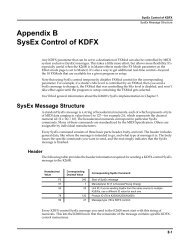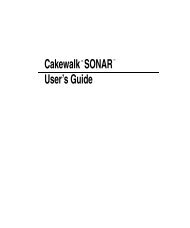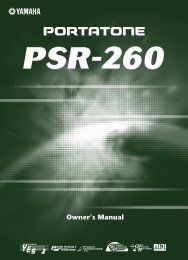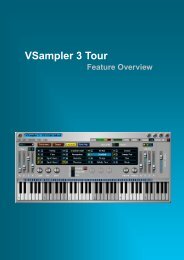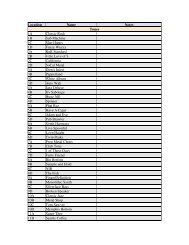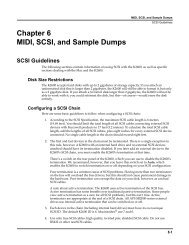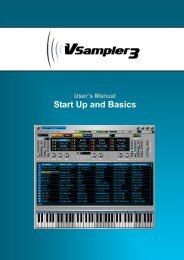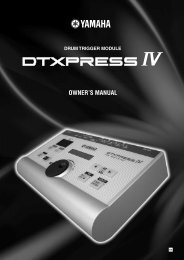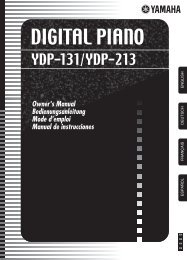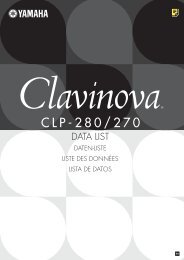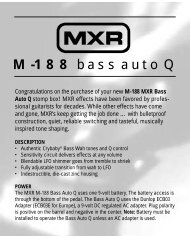Line 6 Bass POD xt Live User Manual - MIDI Manuals
Line 6 Bass POD xt Live User Manual - MIDI Manuals
Line 6 Bass POD xt Live User Manual - MIDI Manuals
- No tags were found...
You also want an ePaper? Increase the reach of your titles
YUMPU automatically turns print PDFs into web optimized ePapers that Google loves.
GETTING SET UP • On Stage3 • 6Getting The Right Tone With An AmpThe first thing to consider when running <strong>Bass</strong> <strong>POD</strong>XT <strong>Live</strong> in front of an amp is whatyou want to achieve. If you want to use your amp for its tone, with <strong>Bass</strong> <strong>POD</strong><strong>xt</strong> <strong>Live</strong>supplying effects and some e<strong>xt</strong>ra distortion when needed, then you’ll generally get thebest results turning the AMP 19 off on <strong>Bass</strong> <strong>POD</strong>XT <strong>Live</strong>, and using STOMP 19when you want to add distortion. The sounds that are pre-programmed in Banks 9-16are set up this way, to complement the tone provided by your amp. For this setup, you’llwant to plug right into your amp’s front panel bass input, and be sure you’ve made theproper choice of LIVE W HORN, LIVE W H EQ, LIVE NO HORN, or LIVE NO H EQ onthe “What are you connecting to?” system page (see page 3•3).On the other hand, if you want to use <strong>Bass</strong> <strong>POD</strong>XT <strong>Live</strong>’s Amp Modeling ability totransform the basic tone of your amp to make it sound more like another amp, you’llprobably want the AMP 19 processing on, as you’ll find it in the pre-programmedsounds in Banks 1-8. If you’ve got an amp with effect send/return jacks, or a power ampinput, we recommend you first try feeding your <strong>Bass</strong> <strong>POD</strong>XT <strong>Live</strong>’s input into them,bypassing your bass amp’s own preamp and its tone contribution. If your amp doesn’thave these input jacks, just go right into its bass input. Either way, be sure you’ve madethe proper choice of LIVE WITH HORN WITH EQ, LIVE WITH HORN NO EQ, LIVE NOHORN WITH EQ, or LIVE NO HORN NO EQ on the “What are you connecting to?”system page (see page 3•3).It’s also important to be realistic about what you’re going to achieve here — as good asit is, <strong>Bass</strong> <strong>POD</strong>XT <strong>Live</strong> won’t be able to make a $100 combo amp with a cheap speakersound exactly like the vintage amp of your dreams. When you’re plugging into the frontof an amp, it’s a good idea to start off with that amp in neutral. What is “neutral,” youask? Well, if you only have one volume control on your amp, set it low enough to get a“clean” tone; that ensures <strong>Bass</strong> <strong>POD</strong>XT <strong>Live</strong>’s sounds come through as purely aspossible. If you have a master volume in addition to a volume control on the input, setthem both so that the first volume doesn’t overdrive the master volume (so you’regetting a clean tone). This will vary from amp to amp, but usually the input volume isgoing to be less than the master volume to get a clean, non-distorted sound. If you havepassive tone controls, try setting your mid control at max, and your treble and basscontrols at zero (this is actually “flat” equalization-wise on most amps). Active tonecontrols may vary, but just be sure you’re not overdriving the amp so the <strong>Bass</strong> <strong>POD</strong>XT<strong>Live</strong> tone comes through without e<strong>xt</strong>ra coloration. Once you get going, you can tweakthe amplifier settings to suit your tastes. Try to set <strong>Bass</strong> <strong>POD</strong>XT <strong>Live</strong>’s rear panel LEVEL6 knob so you’re not overdriving the input of the amp.



